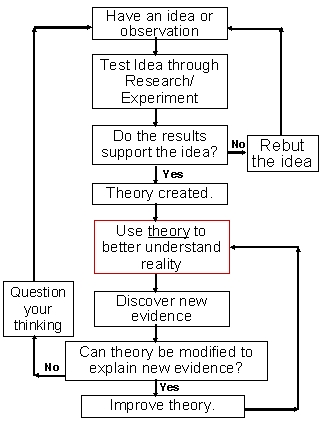Scientific Method // Método científico
Honest-to-goodness research has always relied upon the so-called SCIENTIFIC METHOD to ensure that, especially in the physical sciences, our statements about the reality around us are closer to the truth. Any google search of the term “scientific method” would generate an unlimited number of links. Most of them would give you a series of steps, something like:

In January 2009, a website called Understanding Science (www.understandingscience.org) was launched, funded by the National Science Foundation. It presents an alternative to the scientific method: the science flow chart. Please click here:
http://undsci.berkeley.edu/article/scienceflowchart
The flow chart illustrates :
1) how scientific investigations may be inspired by a wide range of inputs, from serendipitous occurrences to practical problems in need of a solution.
2) Next is the gathering and interpretation of data through “testing ideas,” which is at the center of the flow chart and at the core of science.
3) From here, the next step may be :
a. interactions with the scientific community,
b. further testing,
c. investigation of new questions, or
d. applying scientific knowledge.
The chart emphasizes that science is an iterative, dynamic process involving a community of scientists engaged in many different activities. (Source: Susan Musante, A Dynamic Alternative to the Scientific Method. Bioscience, Jan2009, Vol. 59, Issue 1.)
—————
Applications to our UNIV Research:
For example: You want to investigate the idea: “Christianity Influencing Music”.
Your hypothesis might be: “Christian Faith has indeed influenced music from the olden times up to the present day.”
You might want to test this hypothesis by, say, administering a survey among experts in the field of music or, if your study is just exploratory, among a convenience sample of individuals, say, students in your university.
The contents/form of the survey would, in turn, rely upon a complete or sound literature review: you would scour the ‘world’ of resources out there, read through the material, and write out an integrated review of related literature.
(Actually, writing out briefly the results of your literature review would make a great UNIV Paper 🙂 In any case, your survey would back up any practical or applied or prescriptive aspect of your research on music, e.g., you want to write on “How Christian Music Uplifts One’s Spirits”.)
Otro ejemplo: Quieres escribir sobre el tema “Cuidados paliativos: Su origen cristiano”. Supongamos que tu hipótesis es: “Los cuidados paliativos tienen su origen en la práctica de la fe y de la religión de los médicos cristianos.”
Procedes a una prueba de esta hipótesis, por medio de un repaso de la literatura acerca del tema. Hay un montón de recursos y fuentes: en la biblioteca, en bases de datos en línea, etc. Luego completas esa revisión y escribes una breve historia del asunto. (Normalmente, a base de este proceso, ya se puede confeccionar una sencilla pero completa ponencia para el UNIV…)
Si estás escribiendo algo preceptivo o recomendatorio, procederías a hacer una encuesta, por ejemplo, y escogerías la muestra de individuales adecuado para tu tema. Esto se hará si investigas, p.ej., la cuestión “Cómo aumentar la utilización de cuidados paliativos para los enfermos en fase terminal en Región XX”. Entonces recoges los resultados de tal encuesta y empiezas a escribir las conclusiones, depende de si la experimentación coincide o no con tu hipótesis.
😉 😉 😉
Espero esta página haya servido de ayuda para tu trabajo de investigación…
Si tienes preguntas, no dudes en mandarme mail: aliza.racelis@up.edu.ph
😉 😉 😉
Leave a comment